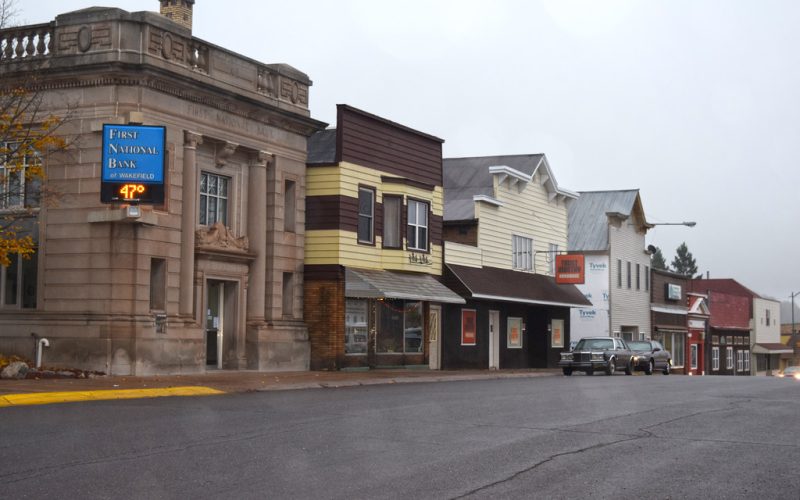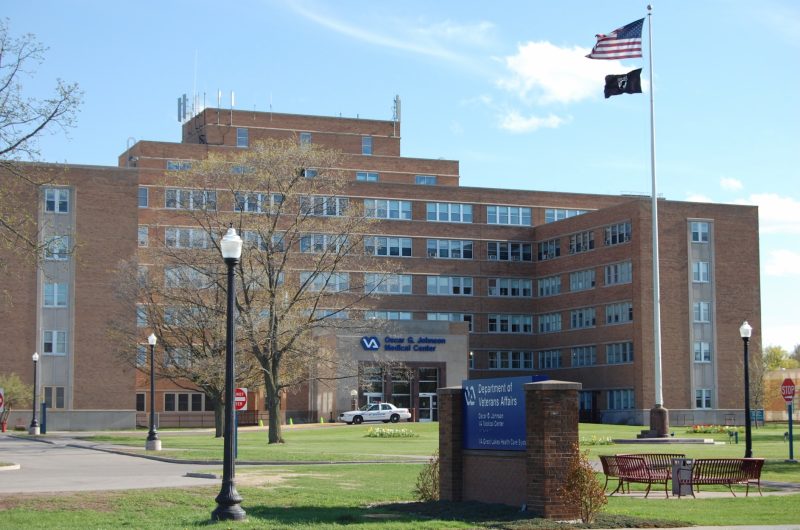Local Government Officials’ Assessments of Community Poverty in the Upper Peninsula

We are publishing this article by Mia Brodeur, a Research Assistant at the University of Michigan Ford School of Public Policy’s Center for Local, State, and Urban Policy (CLOSUP), that explores the issue of poverty in the Upper Peninsula and how local government leaders perceive and address this challenge.
These findings are derived from the Spring 2018 Michigan Public Policy Survey and reveal that UP leaders consistently report higher unmet needs for anti-poverty resources compared to their counterparts downstate. Our goal at Rural Insights is to foster informed discussions around how we can solve the unique rural challenges that we face.
This is the first in a series from the “CLOSE UP on the UP” project, a collaboration between CLOSUP, U-M’s UP Scholars Program, and Rural Insights.
A team of undergraduate students from the UP who attend the University of Michigan are using CLOSUP survey data, with a particular emphasis on the responses from over 130 local governments in Michigan’s Upper Peninsula who respond each survey wave, to look at issues important to their home region and analyze the insights of the UP’s local government leaders.
We are keen on sharing this because it highlights the socio-economic challenges we face in the UP. By examining local leaders’ perceptions of poverty and resource gaps, this article underscores the need for tailored policies that address specific regional needs.
Special note from CLOSUP:
If you are a UP county, city, village, or township official, please consider participating in the Spring 2024 wave of the Michigan Public Policy Survey (MPPS) from the University of Michigan’s Center for Local, State, and Urban Policy (CLOSUP). It’s important for the survey findings to include UP governments’ perspectives on questions about the challenges facing local communities across the state. This year’s survey is asking about public safety in your jurisdiction and law enforcement practices across the state. Please make sure your UP government’s voice is heard.
Local government leaders in Michigan’s Upper Peninsula (U.P.) are more likely to report significant unmet needs among their residents for anti-poverty resources compared with local leaders in the Lower Peninsula. U.P. leaders are also more likely to believe that their government is doing ‘too little’ to address local poverty.
In the statewide Spring 2018 Michigan Public Policy Survey (MPPS), local leaders were asked about their views on community poverty and for personal assessments of their government’s role in addressing it. The first question analyzed here inquired about which anti-poverty policies had been discussed by a jurisdiction’s government within the past 12 months, regardless of the jurisdiction’s ability to implement that policy.
Looking at six specific policies, U.P. leaders indicated that their governments had discussed several of these topics less frequently than those in the Lower Peninsula. Note that differences of 2% or less are within the margin of error.

Table 1. Percentage of jurisdictions that report various anti-poverty resources were a topic of discussion in their government within the last 12 months, separated by region. (Spring 2018 MPPS)
However, there were two areas which U.P. leaders indicated they discussed more frequently: drug treatment programs and job training/workforce development. Further, in a series of questions where respondents were asked to indicate the extent to which residents in their community have the services or resources they require to make ends meet, U.P. leaders also reported more significant unmet needs in these two areas than Lower Peninsula leaders.

Table 2. Percentage of jurisdictions that report various anti-poverty resources were a topic of discussion in their government within the last 12 months, separated by region. (Spring 2018 MPPS)

Figure 1. Local leaders’ perceptions of the need for drug treatment programs in their community to help make ends meet, separated by region. (Spring 2018 MPPS)
Figure 1 shows that 29% of U.P. jurisdictions responded that their residents had significant unmet needs when it came to drug treatment programs, as compared to 19% of Lower Peninsula jurisdictions.

Figure 2. Local leaders’ perceptions of the need for job training/workforce development in their community to help make ends meet, separated by region. (Spring 2018 MPPS)
Similarly, Figure 2 shows that while 28% of U.P. jurisdictions responded that their residents had significant unmet needs for job training/workforce development, only 14% of Lower Peninsula jurisdictions indicated significant unmet needs.
In fact, in 2018, U.P. local leaders were more likely to report significant unmet needs among their residents for every anti-poverty service, except affordable housing. However, by 2023, U.P. leaders’ concerns about local affordable housing had caught up with and surpassed the rest of the state. A closer look at this topic is found in a 2023 MPPS statewide housing report.
At the same time that U.P. local leaders were reporting higher significant unmet needs, Figure 3 shows that U.P. leaders were also saying their jurisdiction is doing too little to address local poverty (19%), or that they don’t know (24%), more frequently than jurisdictions in the Lower Peninsula. This contrasts with how U.P. leaders gave the lowest percentage of “don’t know” responses in the questions about unmet needs above.
The significance of “don’t know” answers across the state may reflect the attitudes of rural Michigan governments. Small jurisdictions don’t receive annual federal poverty statistics, and are therefore less informed on how their district’s actions compare to those of larger districts. Similarly, small jurisdictions are significantly less likely to provide anti-poverty services compared to their larger counterparts, again contributing to a lack of familiarity with these issues. More of this is explored in the 2018 MPPS statewide community poverty report.

Figure 3. Local leaders’ assessments of whether jurisdiction does too much or too little to address local poverty or economic hardship. (Spring 2018 MPPS)
“Voices of the Upper Peninsula”
The MPPS sometimes provides respondents with the opportunity to provide additional descriptions through open-ended items on the survey. When given an opportunity to evaluate the effectiveness of any of their jurisdiction’s “policies or programs that address poverty or economic hardship” (Q24 MPPS Spring 2018), only six of the 108 answers were from the Upper Peninsula.
Despite the lack of U.P. voices, the respondents’ opinions were varied. Three of them mentioned payment programs which help residents with overdue utility bills avoid shut-offs. One respondent additionally stressed that, “The resident must keep up with their payments under the plan.”
Another respondent wrote that, “Sadly, I would say no current policies are working particularly well because we lack the financial resources to become effective in these types of efforts.” This suggests that lack of financial resources could be a factor that influences assessments about how effectively a jurisdiction has addressed local poverty. In this case, communities who feel their financial resources pose a barrier to policy implementation may be inclined to see their government as doing too little.
On the other hand, one respondent was of the opinion that current government assistance programs were doing too much, hindering workforce numbers. The respondent wrote, “There is a greater government push for social benefit programs than there is to get people motivated to work.” They elaborated, “We are located in an area where there [are] numerous jobs available. NUMEROUS JOBS of all levels. We lack the work force because the people’s welfare benefits are much more comfortable to them than getting out of bed and going to work.” This is one reason why a government official may have responded that their jurisdiction is doing too much.
It is important, however, not to generalize these few opinions as speaking for all U.P. local leaders. An interesting follow-up would be to gather more anecdotes from said U.P. government officials and compare and contrast their opinions to those from leaders in the Lower Peninsula.
Overall, this analysis points to how region – whether the Upper Peninsula or the Lower Peninsula – influences how government leaders view both their community’s needs and their own governmental actions. U.P. leaders reported that they discussed many anti-poverty topics less often than Lower Peninsula leaders, yet at the same time indicated greater significant unmet needs for anti-poverty resources. Therefore, paying attention to regional differences is clearly important when making decisions about how best to support Michigan’s local governments.
These assessments are based on statewide surveys of local government leaders from the Michigan Public Policy Survey (MPPS). Since 2009, the University of Michigan’s Center for Local, State, and Urban Policy (CLOSUP) has conducted the MPPS to gather the insights and concerns of elected and appointed officials from all 1,856 of Michigan’s general purpose local governments on a wide variety of topics.
The spring 2018 wave received responses from 143 Upper Peninsula jurisdictions, including 10 counties, 20 cities, 9 villages, and 104 townships.
CLOSUP staff are available to answer questions and help interpret the data (by email at closup-mpps@umich.edu or by phone at 734-647-4091).
For more information about the MPPS program, see: https://closup.umich.edu/michigan-public-policy-survey. And for more information about U-M’s UP Scholars program, see: https://lsa.umich.edu/scholarships/UPScholars.html.






Thank you again for this valuable information. I have forwarded it to the Garfield Township supervisor. Engadine. He was not aware of this or your email blast. Please keep up the good work. Thank you!
Thank you for this!
I’m trying to figure out if there is enough “meaningful” information that will make department heads and legislators take action. And, what action should be taken?
This data is from 2018. Pre-COVID. Six years ago. It is rather outdated. Much has changed in the last five years…housing costs, remote work, and inflation, just to mention a few factors. It will be interesting to compare data from the 2024 survey when it is available. In the meantime, we should probably consider data from the 2018 survey as historical.
How about getting big pharma and its complicit medical professionals to pitch in and carry some of the financial burden of drug treatment ?
Go ahead and require the same complicit crew to pay for the care and cost of vax damages, too.